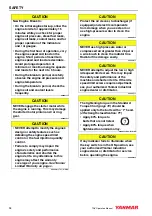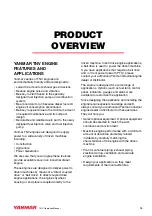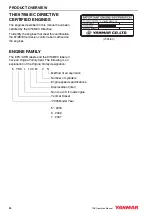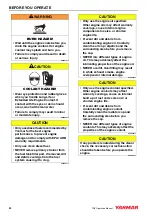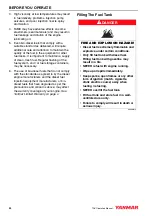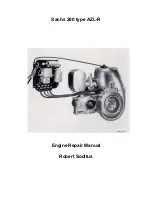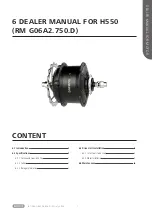
PRODUCT OVERVIEW
TNV Operation Manual
23
FUNCTION OF COOLING SYSTEM COMPONENTS
Components
Functions
Cooling System
The TNV engine is liquid-cooled by means of a cooling system. The
cooling system consists of a radiator, radiator cap, engine cooling
fan, engine coolant pump, thermostat, and reserve tank.
Note that
all cooling system components are required for proper engine
operation. Since some of the components are application
specific, they must be carefully selected by an application
engineer. The application specific items are not part of the
basic engine package as shipped from the Yanmar factory.
• Engine Cooling Fan
The engine cooling fan is driven by a V-belt which is powered by the
crankshaft V-pulley. The purpose of the engine cooling fan is to
circulate air through the radiator.
• Engine Coolant Pump
The engine coolant pump circulates the engine coolant through the
cylinder block and cylinder head and returns the engine coolant to
the radiator.
• Radiator
The radiator acts as a heat exchanger. As the engine coolant
circulates through the cylinder block it absorbs heat. The heat in the
engine coolant is dissipated in the radiator. As the engine cooling
fan circulates air through the radiator, the heat is transferred to the
air.
• Radiator Cap
The radiator cap controls the cooling system pressure. The cooling
system is pressurized to raise the boiling point of the engine
coolant. As the engine coolant temperature rises, the system
pressure and the coolant volume increases. When the pressure
reaches a preset value, the release valve in the radiator cap opens
and the excess engine coolant flows into the reserve tank. As the
engine coolant temperature is reduced, the system pressure and
volume is reduced and the vacuum valve in the radiator cap opens
allowing engine coolant to flow from the reserve tank back into the
radiator.
• Reserve Tank
The reserve tank contains the overflow of engine coolant from the
radiator. If you need to add engine coolant to the system, add it to
the reserve tank; not the radiator.
• Thermostat
A thermostat is placed in the cooling system to prevent engine
coolant from circulating into the radiator until the engine coolant
temperature reaches a preset temperature. When the engine is
cold, no engine coolant flows through the radiator. Once the engine
reaches its operating temperature the thermostat opens and allows
engine coolant to flow through the radiator. By letting the engine
warm up as quickly as possible, the thermostat reduces engine
wear, deposits and emissions.
Summary of Contents for 2TNV70
Page 1: ......
Page 2: ......
Page 32: ...SAFETY 14 TNV Operation Manual ...
Page 116: ...PERIODIC MAINTENANCE 98 TNV Operation Manual ...
Page 140: ...SPECIFICATIONS 122 TNV Operation Manual ...
Page 141: ......
Page 142: ......




